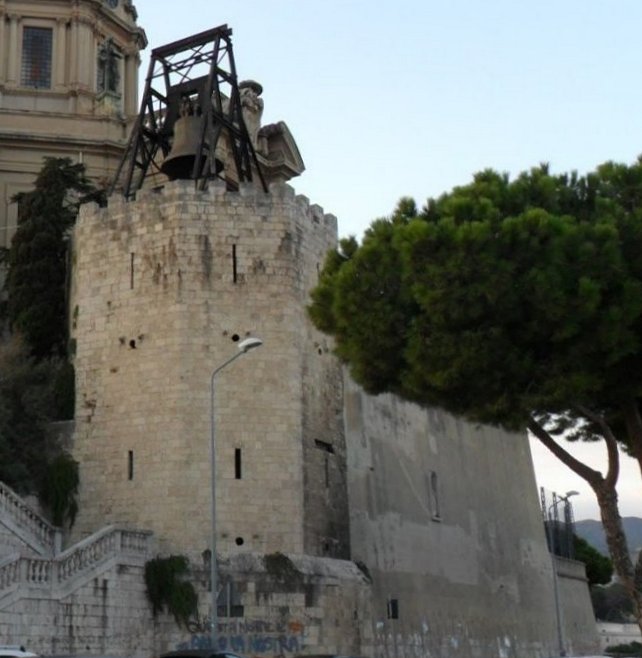Messina

Messina occupies the Sicilian side of the shortest crossing to
Regina on the mainland and in the Hellenistic era was known as
Zancle. There may well have been a Roman
fortification here, but any trace of this is now lost. A
fortification was mentioned near Messina as early as 1061 when Amato di
Montecassino (d. between 1090&1100) states that Roberto Guiscard (d.1085) built a great fortress at Messina. Twenty years later, in 1081, Malaterra recorded that Count Roger
(d.1101) had strengthened the defences of the town through the
construction of a castle with towers. It would appear that this castle was
still standing on 5 April 1168 when it was the site of the imprisonment
of Odo Quarrel. Then it was called the Old Castle which stands in
the harbour by the New Church. Odo was subsequently taken from
the castle and ritually murdered.
In 1190 King Richard I of England (d.1199), on his way to the Holy Land, occupied Messina, and built a new wooden castle called Malegriffon. This was destroyed by King Tancred (d.1194) when Richard left the island in 1191. The castle only appears to have been rebuilt under Frederick II (d.1250), as one of his documents of 1240 refers to a castrum novum in Messina. This was surrendered by Peter Ruffo to the Messinans in December 1254 after his defeat at Piazza Armerina.
The city however remained in rebellion and loyal to the pope,
until in early 1256 the rebels, under Roger Fimetta of Lentini were
defeated in the field at Favara, they then surrendered to Manfred (d.1266) as regent to King Conradin (d.1268) in May 1256.
It was recorded by King Charles' chancellor in 1272 that there were 2 castles in Messina, Matagrifone and Rocca Guelphonia and that there was a garrison of 50 knights there.
Alaimo Lentini of Nicosia opposed King Charles (d.1285) from here during the Sicilian uprising, until he was relieved by King Peter (d.1285) in August 1282. In 1283 castrum novumis
was set on fire by the victorious population, but was later repaired as
a residence for Queen Constance (d.1302). Alaimo's wife, Machalda
Scaletta, and her children were later held
captive in the fortress after their downfall for allegedly plotting
against the same king. However by 1460, all the fortifications of
Messina, including its castle, were in ruins.
By the fifteenth century the castle site was definitely at Malegriffon
when King Ferdinand of Aragon (d.1516), the ruler of Sicily, ordered it
refortified. An inscription of 1496 concerning this still
survives in the current bell tower. After an explosion in 1516
the castle was reinforced with outer defences similar to those raised
at Milazzo. Two hundred years later
the fortress had been abandoned and became a convent for the barefoot
Augustinians in 1759, before being converted into a prison in
1838. Ten years later the Messinese rose in revolt and besieged
and damaged the castle remains, while finally the earthquake of 1908
did irreparable damage to the structure. Finally in 1937 the
current church was built on the site.
Description
Little now remains of the castle which is presumed to be on the site of
King Richard's Malegriffon, other than an octagonal tower being used as
a bell tower and its associated strip of curtain walling. This
stands on a 200' high hill which commands the port. What remains
seems to have been part of a quadrangular keep, which was reinforced in
the sixteenth century by and outer ward with circular towers on three
sides. In the remaining tower is an inscription relating to
Ferdinando the Catholic and dated to 1496. The tower is now used
as the base for the bell tower of the church of Christ the King, which
stands within the site of the keep. Some sixteenth century ruins
remain, mostly hidden within residential buildings.
Why not join me at other Sicilian
castles? Information on this and other tours can be found at Scholarly
Sojourns.
Copyright©2019
Paul Martin Remfry

